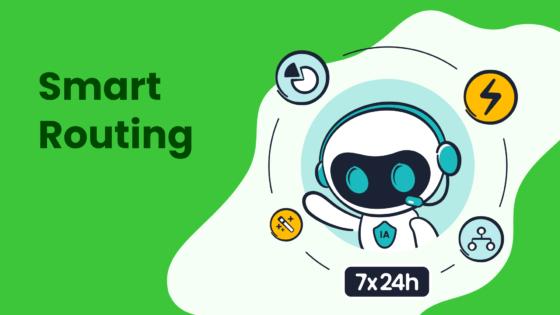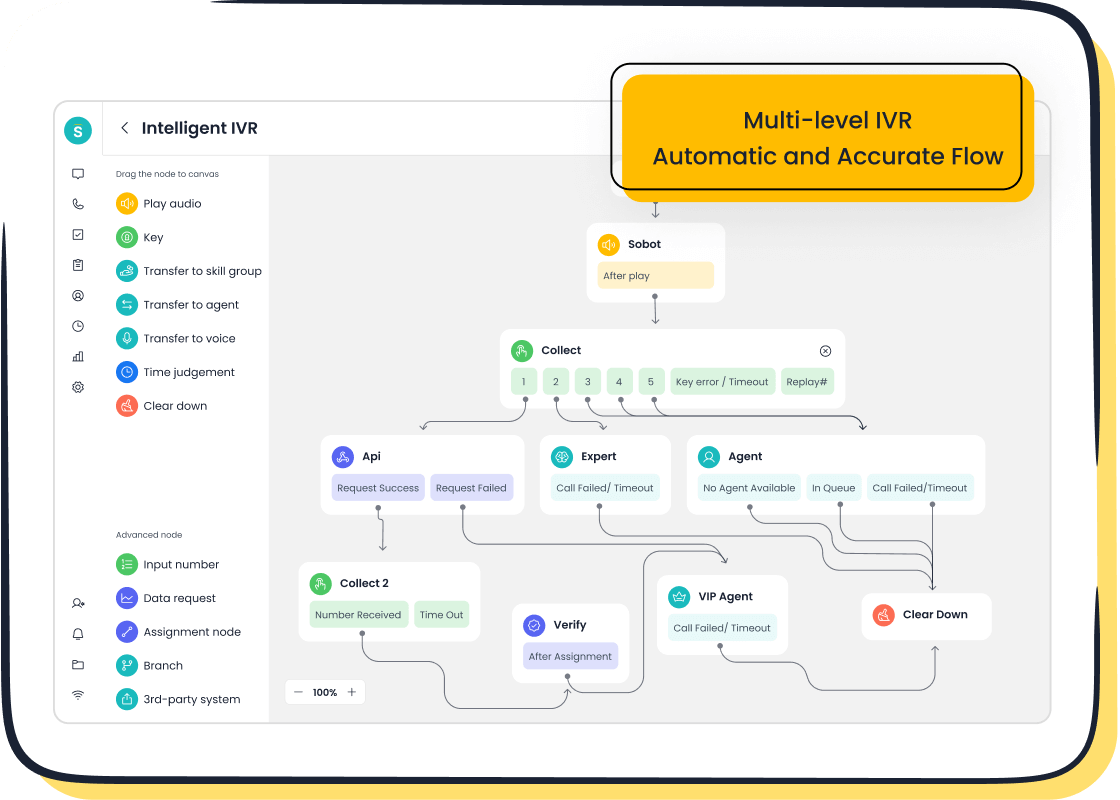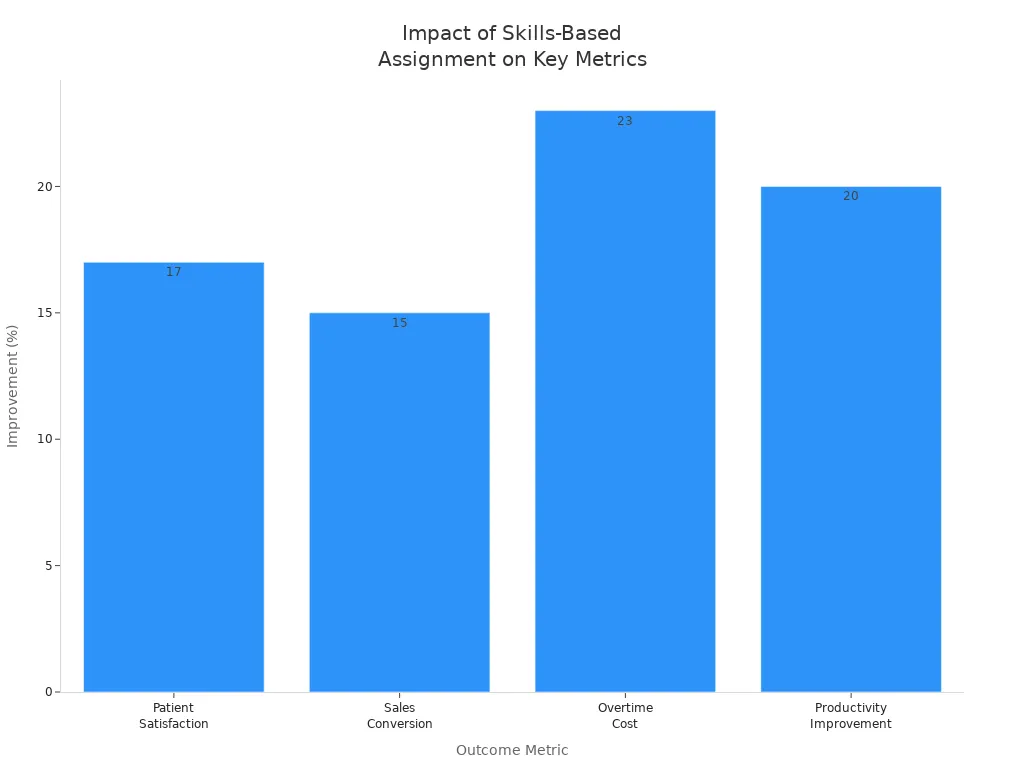10 Best Practices for Automated Call Centers in 2025

Automated call centers in 2025 thrive when you follow these 10 call center best practices: set clear goals, choose the right platform, use AI for customer service, optimize routing, integrate omnichannel support, automate tasks, deliver personalized experiences, analyze performance, train agents, and drive continuous improvement. AI-powered solutions now handle repetitive tasks and support agents in real time, driving operational efficiency and boosting productivity. As shown below, adoption of automation continues to grow:
| Statistic / Insight | Detail | Source |
|---|---|---|
| Automated agent interactions projected to rise from 1.6% in 2022 to 10% by 2026 | Significant increase in automation adoption rate | Gartner |
| 56% of business leaders expect generative AI to boost efficiency | Positive business sentiment | Deloitte Digital |
You can see how Sobot and Sobot AI help companies like Agilent achieve six times higher customer service efficiency, 25% cost reduction, and 95% customer satisfaction by combining personalized AI chatbots and omnichannel platforms. These best practices for call center automation will help you deliver personalized, seamless, and effective customer experiences.
Define Clear Automation Goals
Setting Objectives
You need to start your call center automation journey with clear, measurable objectives. Leading call centers in 2025 focus on goals that drive both efficiency and customer satisfaction. Here are some of the most common objectives you should consider:
- Reduce cost per contact by optimizing self-service and automating workflows.
- Innovate with the latest customer service technologies to stay ahead.
- Prioritize mobile support by making sure your chatbots and channels work well on smartphones.
- Use automation to fill human gaps, such as AI-powered chatbots and automated notifications.
- Improve customer experience and agent productivity.
- Streamline workflows and ensure your operations can scale as your business grows.
- Support agents with real-time assistance and supervisors with analytics.
- Enhance self-service options like IVR and virtual agents.
Tip: Set clear, trackable goals based on your business needs and call data. For example, you might aim to increase your First-Contact Resolution (FCR) rate or reduce average handle time.
A proven framework for setting automation objectives includes these steps:
- Assess your current infrastructure to find gaps and automation opportunities.
- Choose automation tools that fit your needs and integrate with your systems.
- Develop a phased plan, starting with simple tasks and moving to complex ones.
- Train your team on new tools and their role in customer service.
- Test automation in pilot phases and adjust based on feedback.
- Monitor key performance indicators (KPIs) like customer satisfaction and response times.
- Optimize and scale your automation as your needs evolve.
Sobot helps you set and achieve these goals with solutions that unify your channels, automate workflows, and provide real-time analytics.
Measuring Success
You must measure the impact of call center automation to ensure you meet your objectives. Automated KPI tracking gives you real-time insights and reduces manual errors. This allows you to focus on strategic improvements and customer satisfaction.
| KPI Name | Description | Why It Matters |
|---|---|---|
| Automated Contact Resolution Rate | Percentage of inquiries resolved by automation without human help. | Shows how well automation solves issues. |
| Average Speed of Answer by AI | Time AI systems take to respond to customers. | Measures responsiveness and efficiency. |
| First-Contact Resolution (FCR) | Percentage of issues solved in the first automated interaction. | Directly impacts cost and satisfaction. |
| Call Deflection | Percentage of calls moved from agents to self-service or digital channels. | Reduces agent workload and costs. |
| Customer Satisfaction (CSAT) | Customer satisfaction with automated services. | Reflects how well automation meets expectations. |
For example, improving FCR from 70% to 95% can save millions each year in large call centers. Sobot’s analytics dashboard helps you track these KPIs, so you can see the real impact of implementing call center automation.
Choose the Right Call Center Platform
Evaluating Automated Call Centers
Selecting the right platform is a critical step in your call center automation journey. The right choice will help you scale, integrate new technologies, and deliver consistent service. In 2025, automated call centers must support rapid business growth and adapt to changing customer needs. You should evaluate platforms using these key criteria:
- Scalability and Flexibility: Make sure the platform can grow with your business. It should allow you to add users and features without downtime.
- Essential Features: Look for AI-driven analytics, advanced call routing, IVR, CRM integration, omnichannel support, predictive dialers, and real-time analytics.
- Integration Capabilities: The platform should connect easily with your CRM, helpdesk, and productivity tools.
- Customer Support and Reliability: Choose a provider with responsive support and clear service level agreements.
- Security and Compliance: Ensure strong data protection and compliance with regulations like GDPR and PCI-DSS.
- Cost and Pricing Flexibility: Select a platform with transparent pricing that fits your business model.
- User-Friendly Interface: A simple interface helps agents learn quickly and reduces errors.
- Robust Reporting and Analytics: Real-time insights help you optimize call center automation.
- Customization and Adaptability: The platform should let you tailor workflows to your needs. 10. Service Level Agreements (SLAs): Look for guaranteed uptime of at least 99% to ensure business continuity.
Tip: Platforms with AI-powered testing and automation, such as predictive quality assurance and omnichannel testing, can help you deliver seamless customer experiences across all channels.
Sobot Voice/Call Center Features

Sobot’s Voice/Call Center stands out as a robust solution for automated call centers. You get a stable system with 99.99% uptime, supporting global operations and high call volumes. Sobot offers intelligent IVR, smart call routing, and AI-powered voicebots to automate routine tasks and improve customer satisfaction. The unified workspace lets agents manage calls, messages, and customer data in one place, boosting productivity.
Sobot’s platform integrates easily with your existing CRM and business tools. You can deploy it quickly and scale as your needs grow. Real-time analytics and monitoring help you track performance and optimize your call center automation strategy. Companies like Agilent have seen a sixfold increase in efficiency and a 25% reduction in costs after adopting Sobot’s solutions. Learn more about Sobot’s Voice/Call Center at Sobot Voice.
Implement AI-Powered Interactions

AI Chatbots in Customer Service
You can transform your customer service by using AI chatbots. These advanced tools handle multiple customer interactions at once, which means shorter queues and faster responses. Many companies now resolve up to 90% of frequent customer issues through chatbots, allowing your agents to focus on complex problems. AI chatbots operate 24/7, so your customers always get support, even outside business hours. This constant availability reduces average response times from several minutes to under two minutes.
AI chatbots use natural language processing to understand customer questions and provide instant, accurate answers. Predictive analytics help these bots anticipate customer needs, offering proactive support that boosts satisfaction. When you leverage AI, you also gain seamless omnichannel support. Chatbots maintain context across platforms, ensuring every customer interaction feels unified and personal. Companies have saved hundreds of hours each month and improved agent retention by automating repetitive tasks. With Sobot’s AI-powered chatbot integration, you can deliver consistent, high-quality customer service while freeing your team for more valuable work.
Tip: Leverage AI chatbots to automate routine tasks and provide self-service options, so your agents can focus on building stronger customer relationships.
Voicebot Automation
Voicebot automation takes call center automation to the next level. AI-powered voicebots can handle a high volume of customer interactions at the same time, reducing wait times and improving satisfaction. For example, organizations using AI voicebots have seen up to a 40% reduction in call handling times, according to Gartner. In one case, a regional insurance provider dropped average wait times from 12 minutes to under 30 seconds and increased customer satisfaction by 22 percentage points.
Voicebots use intelligent call routing, real-time speech analytics, and sentiment analysis to understand customer intent and direct calls efficiently. This technology allows you to leverage AI for smarter, faster, and more secure customer interactions. Sobot’s AI-powered voicebots integrate with your existing systems, providing a stable and scalable solution for global operations. By automating over 80% of routine calls, you can reduce operational costs and deliver a customer-centric experience every time.
Optimize Call Routing Automation
Intelligent Routing
Automated call routing transforms how you manage customer interactions. With intelligent routing, you connect each caller to the best agent based on real-time data, customer history, and the type of issue. This approach reduces wait times and ensures customers do not repeat information. You see fewer transfers and faster resolutions. Research shows that intelligent routing can boost first-call resolution rates by 15-25% and lower operational costs by up to 30%. Customers enjoy a smoother experience, and agents handle only the cases they are best equipped to solve.
Automated call routing also enables 24/7 support. AI-powered systems direct interactions to virtual agents or self-service options outside business hours, so your customers always get help. Sobot’s platform uses intelligent routing to integrate with your CRM, giving agents instant access to customer data and improving every interaction.
You benefit from these proven advantages:
- Reduced call hold times and fewer repeated interactions.
- Higher first-call resolution rates and improved customer loyalty.
- Lower operational costs and fewer human errors.
- Agents focus on complex cases, increasing engagement and job satisfaction.
Skills-Based Assignment
Skills-based assignment takes automated call routing a step further. You match each customer with an agent who has the right expertise for their issue. This method improves first-call resolution and customer satisfaction. Studies show that companies using skills-based routing see a 15-25% improvement in resolution rates and a 10-15 point increase in customer satisfaction scores.
You also reduce call transfers and wait times. Agents feel more engaged because they handle cases that match their skills. Customers receive faster, more accurate answers, which leads to higher retention and loyalty.
Here is how skills-based assignment impacts key metrics:
| Metric / Outcome | Result |
|---|---|
| First-Call Resolution | 15-25% improvement |
| Customer Satisfaction | 10-15 point increase |
| Productivity | 15-20% improvement |
| Overtime Cost | 23% reduction |
| Employee Engagement | Higher job satisfaction and retention |

Sobot’s automated call routing and skills-based assignment features help you streamline operations, automate routine tasks, and deliver exceptional customer interactions. You empower your team to focus on what matters most—solving complex problems and building customer trust.
Integrate Omnichannel Customer Service

Unified Workspace
You need a unified workspace to deliver outstanding customer service in 2025. An omnichannel approach brings all your communication channels—voice, chat, email, and social media—into one platform. This setup lets your agents see every customer interaction in real time. You avoid confusion and reduce the risk of missing important details. Agents can switch between channels without losing context, which means customers get faster, more accurate responses.
A unified workspace also boosts agent productivity. You see fewer repeat contacts and lower average handle times. Studies show that companies using an omnichannel approach reduce repeat contacts by 30% and decrease average handle times by up to 40%. Customer satisfaction scores rise by 25-30% because customers enjoy seamless omnichannel experiences. You also improve agent morale, as they no longer need to juggle multiple systems.
A unified workspace helps you deliver consistent, high-quality customer service across every channel.
Sobot Omnichannel Solution
Sobot’s omnichannel solution gives you a powerful platform to manage all customer interactions. You integrate communication channels like websites, mobile apps, social media, email, and voice into a single workbench. Agents handle every customer request from one place, which streamlines your operations and improves service quality.
Sobot’s AI-powered chatbots and voicebots automate routine tasks and provide 24/7 support. Real-time synchronization of customer information ensures agents always have the latest data. You can personalize every customer interaction and resolve issues faster. Sobot’s analytics tools let you track key metrics, such as First Contact Resolution and Customer Satisfaction, so you can optimize your customer service strategy.
Agilent, a global leader in life sciences, used Sobot’s omnichannel approach to transform its customer service. After implementation, Agilent saw a sixfold increase in efficiency, a 25% reduction in costs, and a 95% customer satisfaction score. Sobot unified Agilent’s customer interactions, reduced agent workload, and improved service consistency. You can read more about Agilent’s results here.
Sobot’s omnichannel solution helps you deliver seamless, personalized customer service and achieve measurable business results.
Automate Routine Tasks
Workflow Automation
You can transform your call center operations by embracing workflow automation. Modern call centers now automate where possible, using AI-powered chatbots and virtual assistants to handle up to 80% of routine customer inquiries. This shift allows you to focus your team on more complex issues and deliver faster service. Robotic Process Automation (RPA) also plays a key role. It automates repetitive tasks like data entry and processing, which reduces handling time by up to 40% and cuts operational costs by 30%. These improvements show that most routine tasks in call centers are now automatable with current technology.
Sobot’s platform supports workflow automation with features like intelligent IVR, AI-powered chatbots, and seamless CRM integration. You can set up automated self-service options that let customers resolve issues on their own, freeing your agents for higher-value work. When you automate where possible, you increase efficiency and improve customer satisfaction.
Note: Automating routine tasks not only speeds up customer interactions but also ensures your business tools stay up-to-date and accurate.
Reducing Manual Work
You reduce manual work in your call center by using the right automation tools. Here are some of the most effective ways to automate where possible:
- Implement Interactive Voice Response (IVR) systems to route customers automatically.
- Use predictive dialers for outbound calls, connecting agents only when a live answer is detected.
- Automate follow-ups through SMS and email, minimizing manual outreach.
- Deploy AI-powered chatbots to handle routine inquiries and provide self-service.
- Integrate CRM systems with automation tools for streamlined data management.
By using these tools, you enable self-service and automated self-service options, which divert routine inquiries from agents. This approach reduces agent workload, minimizes errors, and speeds up customer interactions. Agents can then focus on complex issues, leading to higher first call resolution rates and improved customer satisfaction. Sobot’s unified workspace and automation features help you automate where possible, optimize call center automation, and enhance both agent and customer experiences.
Tip: Automation of routine tasks leads to lower operational costs, better agent satisfaction, and more efficient call center automation.
Personalize Customer Experiences
Data-Driven Personalization
You can create a positive customer service experience by using data-driven personalization in your call center. When you use AI-powered tools, you gain real-time insights into each customer’s needs and preferences. This approach helps you in creating personalized interactions that make customers feel valued and understood.
- 65% of customers say that personalization tactics—like agents having access to full customer history or sending special offers on birthdays—make a big impact.
- A recent survey found that 82% of consumers let personalized experiences influence their brand choices in at least half of their shopping situations (Medallia).
- Personalized interactions lead to a 21% increase in sales, 27% higher customer satisfaction scores, and 25% better retention rates.
You can implement data-driven personalization by following these steps:
- Collect and analyze customer data, including past interactions and feedback.
- Integrate AI tools, such as chatbots and analytics platforms, with your call center systems.
- Continuously monitor and refine your personalization strategies based on customer feedback.
Sobot’s unified workspace and AI-powered analytics help you in creating personalized interactions at scale. You empower your agents with real-time data, so every conversation feels unique and relevant.
Automation for Customer Satisfaction
Automation plays a key role in creating personalized experiences and improving customer satisfaction. You can use AI and automation to deliver fast, tailored responses across every channel. Automated systems track customer preferences, analyze sentiment, and provide proactive support. This approach ensures that each customer receives a personalized solution, not just a generic answer.
- Customer satisfaction scores rise when you respond quickly and resolve issues on the first contact.
- Metrics such as first response time, first contact resolution, and sentiment analysis help you measure the impact of automation on customer experience (McKinsey).
- Empathy and human connection, supported by automation, increase loyalty and repeat business.
Sobot’s omnichannel platform uses automation to streamline workflows and deliver personalized service. You can collect feedback through automated surveys and use AI to detect customer emotions. This process helps you in creating personalized interactions that drive loyalty and satisfaction.
Tip: Training your agents in empathy and active listening, combined with automation, creates a winning formula for customer satisfaction.
Monitor and Analyze Performance
Real-Time Analytics
You need real-time analytics to keep your call center running at peak performance. These tools let you track agent interactions, spot trends, and make quick decisions. You can monitor key metrics like average handle time (AHT), first call resolution (FCR), and customer satisfaction (CSAT) as calls happen. This approach helps you identify bottlenecks and coaching opportunities right away.
Real-time dashboards and alerts notify you of issues such as long wait times or high call volumes, so you can act fast and maintain service quality.
Here are the best practices for using real-time analytics in your call center:
- Focus on customer-centric KPIs like CSAT, CES, NPS, FCR, and AHT.
- Combine quantitative data with AI-driven sentiment and intent analysis.
- Unify reporting across all channels for a single, consistent view.
- Use live dashboards and CRM integration for seamless workflows.
- Gather feedback from every interaction, not just surveys.
Sobot’s analytics platform gives you live insights and integrates with your CRM, so you always have the data you need. One call center reduced abandonment rates by 25% after using real-time queue monitoring and staffing adjustments. Real-time analytics help you implement quality assurance processes that drive continuous improvement and higher customer satisfaction.
Quality Assurance Tools
You must implement quality assurance processes to ensure every customer interaction meets your standards. Modern QA tools use AI to score calls, analyze sentiment, and provide instant feedback. This technology lets you review 100% of interactions, not just a random sample, so you get a complete picture of agent performance.
| QA Tool Feature | Benefit |
|---|---|
| Automated Scoring | Consistent, unbiased evaluations |
| Speech Analytics | Detects sentiment and compliance issues |
| Real-Time Feedback | Enables prompt coaching and corrections |
| Integration | Seamless with CRM and telephony systems |
You can use scorecards aligned with your KPIs to measure call quality. AI-powered tools highlight trends and training needs, helping you implement quality assurance processes that improve both agent skills and customer satisfaction. Sobot’s unified workspace supports these efforts by providing call recording, speech analytics, and real-time monitoring. When you implement quality assurance processes, you build a culture of excellence and ensure your call center delivers consistent, high-quality service.
Train Agents for Automation
Upskilling for Call Center Automation
You must prepare your customer service agents for the future of automation. Upskilling helps your team adapt to new tools and processes. The most effective training programs use a mix of technology, coaching, and hands-on practice. You can:
- Use conversation analytics platforms to gather insights on agent performance.
- Aggregate conversation data to identify top-performing customer service agents.
- Combine automated scoring with manual reviews to target skills for improvement.
- Offer continuous and personalized training to boost confidence and skills.
- Introduce virtual reality simulations and AI-powered tools for real-world practice.
- Support knowledge transfer with mentoring programs.
- Provide product and compliance training to keep your team informed.
- Focus on soft skills like communication, empathy, and multitasking.
- Use microlearning and gamification to make training engaging.
- Build KSAC (Knowledge, Skills, Abilities, Competencies) profiles for each role.
- Outline clear career paths to motivate and retain customer service agents.
Sobot’s unified workspace and analytics help you track progress and tailor training to each agent’s needs. This approach ensures your customer service agents stay ahead in a fast-changing environment.
Tip: Foster open feedback channels so agents can share ideas and improve training programs together.
Continuous Learning
Continuous learning keeps your customer service agents sharp and ready for change. Real-time feedback lets agents adjust their performance right away. Automated QA tools and access to vital information reduce errors and streamline workflows. You create a culture where agents learn from every interaction.
- Real-time feedback boosts agent confidence and skill development.
- Structured QA processes help agents spot mistakes early and fix them.
- Continuous learning empowers agents to meet new customer demands.
- Timely feedback and coaching improve service quality and satisfaction.
Sobot’s platform supports continuous learning with real-time analytics and automated quality assurance. Your customer service agents gain the tools they need to adapt quickly and deliver excellent service every day.
Note: Continuous learning not only improves agent performance but also drives better customer experiences.
Foster Continuous Improvement
Feedback Loops
You drive lasting success in your call center by building strong feedback loops. These loops help you spot trends, address challenges, and keep your team engaged. Effective call center best practices start with sharing insights across agents, managers, and product teams. You act quickly on feedback and monitor the results.
- Share insights with all stakeholders to encourage prompt action.
- Prioritize feedback by severity, frequency, and impact for better resource use.
- Foster collaboration among managers, IT, and frontline agents to find solutions.
- Pilot new ideas, such as AI chatbots, and refine them through agile experimentation.
- Communicate changes clearly and provide targeted training for agents.
- Use real-time monitoring and coaching to reinforce positive behaviors.
- Apply structured Quality Assurance frameworks to measure call etiquette and empathy.
- Gather customer feedback through surveys and post-call follow-ups.
- Collect agent feedback with regular check-ins and anonymous surveys.
- Use predictive analytics to prepare for busy periods and adjust staffing.
- Celebrate success stories to motivate your team and highlight the value of feedback.
You can use Sobot’s unified workspace to collect and analyze feedback from every channel. Real-time analytics and automated surveys help you identify areas for improvement and act fast. This approach keeps your call center best practices up to date and ensures continuous growth.
Adapting Best Practices
You keep your call center ahead by adapting best practices based on data and team input. Analyze key metrics like average handle time, first call resolution, and customer satisfaction scores to find improvement opportunities. Combine these insights with agent feedback from regular meetings and anonymous surveys. This holistic approach helps you tailor coaching and operational strategies.
- Schedule consistent meetings with agents to encourage open dialogue.
- Ensure feedback leads to real changes so agents feel valued.
- Study call flow patterns to optimize resources during peak times.
Sobot’s analytics tools make it easy to track performance and spot trends. You can adjust workflows and training programs quickly. When you adapt call center best practices, you boost engagement, improve service quality, and create a culture of excellence.
Tip: Continuous improvement works best when everyone sees their feedback making a difference. Celebrate wins and share progress to keep your team motivated.
Adopting these best practices helps you boost customer satisfaction, streamline operations, and stay ahead in a changing market. Sobot’s intelligent contact center solutions support your goals with AI-driven automation, unified workspaces, and real-time analytics.
- Over 70% of client interactions will involve AI by 2025, driving operational efficiency and better outcomes.
- Companies see higher customer satisfaction and loyalty with omnichannel support and continuous improvement.
Assess your current system and take the next step. Reach out to Sobot for tailored solutions that fit your business needs.
FAQ
What is call center automation and why does it matter in 2025?
Call center automation uses AI and technology to handle routine tasks, route calls, and support agents. In 2025, automated call centers help you reduce costs, improve customer satisfaction, and boost efficiency. Sobot’s solutions show up to 6x higher service efficiency for real businesses.
How do automated call centers improve customer satisfaction?
Automated call centers use AI chatbots and smart routing to answer questions quickly. You get faster responses and fewer errors. For example, Sobot’s omnichannel platform helped Agilent reach a 95% customer satisfaction score. Learn more about their results here.
What are the top call center best practices for automation?
You should set clear goals, choose the right platform, use AI-powered tools, automate routine tasks, and monitor performance. Sobot’s unified workspace and analytics help you follow these call center best practices for better results.
Can Sobot integrate with my existing CRM or business tools?
Yes, Sobot offers seamless integration with popular CRM and business systems. You can connect your automated call center to your current workflow, making it easier to manage customer data and improve call center automation.
How do I measure the success of my automated call center?
Track key metrics like First Contact Resolution, Average Handle Time, and Customer Satisfaction. Sobot’s analytics dashboard gives you real-time data, so you can see how call center automation improves your results.
Tip: Review your call center best practices regularly to keep your automated call center running smoothly.
See Also
Effective Strategies For Managing Call Center Quality
A Step-By-Step Guide To Omnichannel Contact Centers
Understanding The Efficiency Of Call Center Automation
